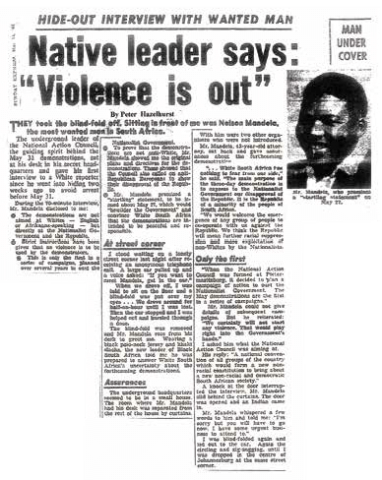Issue:

While a weakened Nelson Mandela battles for his life, a former Member recalls his encounter with the iconIt was probably the best or at least one of the most dramatic leads that I produced in nearly 40 years in journalism. It was also the first and last interview that any journalist held with Mandela before he was betrayed and arrested a few months later.
The contents of that exclusive underground interview with Mandela 52 years ago also proved to be historic, as the African leader assured South Africa’s white supporters of apartheid that they had nothing to fear from black majority rule.
“We want a National Convention of all groups of the country which would form a new, non-racial constitution to bring about a new non-racial and democratic South African society. We will certainly not start any violence. That would play into the governments hands,” he declared, in an attempt to assure an apprehensive but unbending white ruling minority.
In sharp contrast to the opportunistic swings of most politicians worldwide, Mandela never wavered from that statement when after spending 27 years in prison he ushered in relatively peaceful majority rule and a democratic constitution in South Africa in 1993.
In May 1961, the South African police spearheaded by a ruthless political Special Branch had launched a national manhunt for Mandela, then a 42 year old attorney, who was in hiding while organizing the National Action Council, which was planning massive demonstrations against the government to be held on May 31.
The South African government had tarnished Mandela as a dangerous rabble rouser who advocated the violent over throw and suppression of the white ruling minority.
The propaganda had successfully equated Mandela with the hardline policies of the anti-colonial movements in other parts of Africa particularly the Mau Mau in Kenya.
No one had the slightest inkling at the time that Mandela would emerge within four decades as one of the greatest advocates of non-violence on the continent and, ironically, the savior of the white and other non-African minorities in South Africa.
I was then a reporter on the Johannes burg Sunday Express. Naturally, other African leaders in the movement were hesitant to reveal Mandela’s whereabouts, even to journalists. But one of my contacts and a friend, Ruth First, a white supporter of the African National Congress, assured Mandela’s close aides that they could trust me. (Ruth was later killed in Mozambique by a letter bomb designed by the South African Special Branch.)
The go between, Ahmed Kathrada who was to spend 27 years in prison with Mandela walked into the reporters’ room in early May and quietly promised to take me to the African leader within a few hours.
I had no idea of what to expect when this tall imposing figure dressed in a dark polo neck pullover rose to shake hands at a point in history when race relations in South Africa appeared to be on the precipice of an unprecedented disaster.
But within minutes Mandela made it clear he and the ANC were offering the ruling white minority a non violent solution of equal rights in the future of South Africa.
I was left with no doubt that he was genuine.
When I outlined the story to my editors the next day, they were hesitant in providing space to a man who had been labeled as a dangerous advocate of violence a step which could inflame the newspaper’s white readers.
I had taped the interview, and asked the editor of the Sunday Express to listen to the recording before coming to a decision.
As the tape ended, he declared: “We will run the story.”
With rat-like cunning, which has proved to be my main forte in four decades of reporting, I had foreseen that the Special Branch would take an unhealthy interest in anyone with access to Mandela. I insisted that even if I became aware of the meeting place I should be blindfolded to protect contacts who were hiding the African leader.
And within hours of publication my precautions were justified: the Special Branch pulled me in for interrogation.
The head of the Johannesburg Special Branch, a Colonel Att Spengler, and two other interrogators demanded that I expose Mandela’s whereabouts. I simply referred them to the opening paragraph.
After three hours of frustrated questioning, they reluctantly released me with the words: “We are sure you know where Mandela is.” I just shrugged and left.
After Mandela was arrested in August 1962, I was subpoenaed by the prosecutors to give evidence at his first trial. The state required evidence under oath confirming the contents in the article.
I agreed, as I knew Mandela would certainly not retract the statements he had made in his outspoken fight against the Nationalist government and apartheid. And, much to the chagrin of the prosecution, Mandela then cross-examined me, using the court as an instrument to publicize some of the injustices of white minority rule. (He later used extracts from my evidence in his first book, No Easy Walk to Freedom.)
The prosecutors now found they had a hostile witness on their hands. During the recess a senior police officer and a prosecutor approached me outside the court and used threats in an attempt to sway my response to Mandela’s questions.
My responses stuck with the truth. The threats never materialized.
Peter Hazelhurst was Asia correspondent for the Times and a member of the FCCJ from 1972 to 1989.

